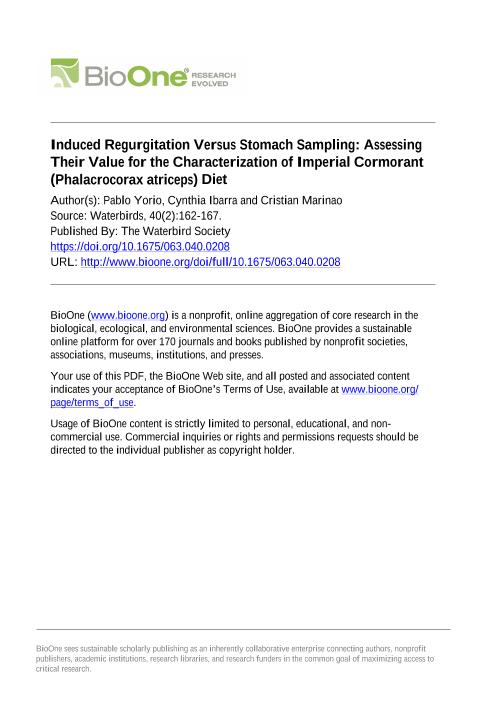Mostrar el registro sencillo del ítem
dc.contributor.author
Yorio, Pablo Martin

dc.contributor.author
Ibarra, Cynthia

dc.contributor.author
Marinao, Cristian Javier

dc.date.available
2018-04-23T15:46:56Z
dc.date.issued
2017-06
dc.identifier.citation
Yorio, Pablo Martin; Ibarra, Cynthia; Marinao, Cristian Javier; Induced Regurgitation Versus Stomach Sampling: Assessing Their Value for the Characterization of Imperial Cormorant (Phalacrocorax atriceps) Diet; Waterbird Society; Waterbirds; 40; 2; 6-2017; 162-167
dc.identifier.issn
1524-4695
dc.identifier.uri
http://hdl.handle.net/11336/43015
dc.description.abstract
Several studies have applied induced regurgitations to characterize the diet of cormorants, but none have presented quantitative information indicating complete stomach contents were obtained. Our goal was to test the value of induced regurgitations for the assessment and monitoring of Imperial Cormorant (Phalacrocorax atriceps) diet. Stomach samples were obtained from male and female breeding adults bringing food back to the colony during the chick rearing stage (n = 22) at Isla Arce, Argentina. Samples were obtained through induced regurgitation, and immediately afterward each individual was flushed with sea water. The diet of the Imperial Cormorant consisted of at least 23 prey taxa, mostly fish complemented by crustaceans, cephalopods and polychaetes. However, only Argentine anchovy (Engraulis anchoita) and rockcods (Patagonotothen spp.) showed a significant contribution by mass (70.7% and 25.3%, respectively). Analysis of similarity indicated that prey composition between samples obtained by induced regurgitation and those obtained by combining regurgitation followed by stomach flushing were similar in both the numerical frequency of all prey taxa recorded and the contribution by mass of the main prey. Our results show that induced regurgitation provides complete stomach contents, and thus validates the use of this technique for quantifying Imperial Cormorant diet composition.
dc.format
application/pdf
dc.language.iso
eng
dc.publisher
Waterbird Society

dc.rights
info:eu-repo/semantics/openAccess
dc.rights.uri
https://creativecommons.org/licenses/by-nc-sa/2.5/ar/
dc.subject
ARGENTINA
dc.subject
DIET METHODS
dc.subject
GOLFO SAN JORGE
dc.subject
IMPERIAL CORMORANT
dc.subject
PHALACROCORAX ATRICEPS
dc.subject
SEABIRDS
dc.subject.classification
Otras Ciencias Biológicas

dc.subject.classification
Ciencias Biológicas

dc.subject.classification
CIENCIAS NATURALES Y EXACTAS

dc.title
Induced Regurgitation Versus Stomach Sampling: Assessing Their Value for the Characterization of Imperial Cormorant (Phalacrocorax atriceps) Diet
dc.type
info:eu-repo/semantics/article
dc.type
info:ar-repo/semantics/artículo
dc.type
info:eu-repo/semantics/publishedVersion
dc.date.updated
2018-04-05T18:24:35Z
dc.identifier.eissn
1938-5390
dc.journal.volume
40
dc.journal.number
2
dc.journal.pagination
162-167
dc.journal.pais
Estados Unidos

dc.journal.ciudad
De Leon
dc.description.fil
Fil: Yorio, Pablo Martin. Consejo Nacional de Investigaciones Científicas y Técnicas. Centro Científico Tecnológico Conicet - Centro Nacional Patagónico. Centro para el Estudio de Sistemas Marinos; Argentina. Wildlife Conservation Society; Estados Unidos
dc.description.fil
Fil: Ibarra, Cynthia. Consejo Nacional de Investigaciones Científicas y Técnicas; Argentina. Universidad Nacional de la Patagonia; Argentina
dc.description.fil
Fil: Marinao, Cristian Javier. Consejo Nacional de Investigaciones Científicas y Técnicas. Centro Científico Tecnológico Conicet - Centro Nacional Patagónico. Centro para el Estudio de Sistemas Marinos; Argentina
dc.journal.title
Waterbirds

dc.relation.alternativeid
info:eu-repo/semantics/altIdentifier/doi/http://dx.doi.org/10.1675/063.040.0208
dc.relation.alternativeid
info:eu-repo/semantics/altIdentifier/url/http://www.bioone.org/doi/10.1675/063.040.0208
Archivos asociados
